Gregory Tube Amps
By Paul Marossy
Last updated 1/24/24
After picking up the Mark X amp, I was intrigued by these mysterious Gregory amplifiers and
thought I would do some research as to what they offered and who they were. It's amazing to me that so many models were offered and yet most people have never heard of Gregory amps before!
I have almost no information on who they were other than they were allegedly based out of Elizabeth, NJ, and built cheaply made amps in the 1950s into the late 1960s.
Gregory Amps was allegedly was a "private company owned by Harmony". They all share the
same method of construction with the partial chassis and enclosure design. Many of the models offered were designed around 7189 output tubes, which are an EL84 variant. And several of
their models utilized a 12AU6 input tube, which is a pentode - a little unusual in the guitar amp world, but it is also part of the secret as to why some of these Gregory amp models sound
very good. Anyhow, I have had a little more success in finding out what they manufactured. So far, I have discovered that they offered at least twenty two different models during the time
that they were in business, although based on my research so far I think some of their later models are possibly re-worked versions of earlier models in a different package with different
names and cosmetics. Below are some details on what I have found thus far.
Here's an update (8/7/08): I have recently obtained a copy of the brochure that was included with a
Gregory Amp which states the company address as being in Bronx, NY. It also says "Amplifiers from $33.00 to $229.95" on it, and includes a list of Gregory Amp service reps in various
states.
Here's another update (6/11/09): I recently discovered that Gregory amps were made in the 1950s-1960s, and were a private brand made by Harmony (Source: Vintage Guitar
Price Guide). Another interesting piece of information! That would seem to explain why they had so many models available, and why they look somewhat similar to some of the later
manufacture Harmony amp models. It's interesting how these Gregory amps have faded into oblivion in spite of that. These amps can be picked up for very little cash and most of the
models reportedly sound very good.
Here's the latest update (9/05/11): One writer suggests that "amps that were sold by Montgomery-Wards are likely Gregory's- at least two models
were dead ringers for Gregorys, except with different names. I own a
Model 6000
that is the same as a Gregory Mark 6". Seems like a possibility to me.
Here's another addition: (11/23/12): Someone wrote me about the potential dangers involved with the Mark I, II, V & VI models. These particular amps use the single diode 35W4 half-wave
rectifier tube and do not even have a power transformer. Therefore, because there is no isolation transformer (power transformer), they are potentially dangerous to use. Apparently
these kinds of circuits were originally used in Ham radios where a protective wood layer surrounded the chassis so it was safe to touch and use. Since there is no power transformer
and a single diode half wave rectifier was used, it was a very cheap power supply circuit to build - which is consistent with just how cheaply made these Gregory amps are.
These transformerless designs were apparently lifted from Ham radios for use in these small tube guitar amps because they were cheap to build, and a side effect is that it created
what is sometimes called a "hot chassis". This was long before the days when UL listing for electrical devices was a requirement. For safety reasons, these amps really ought to be
converted to a safer power supply and use a grounded power cord.

Mark I
 |
This is the Mark 1, a combo amp with a single 6" speaker. This particular amp has a date stamp inside of it from March 25, 1955. |
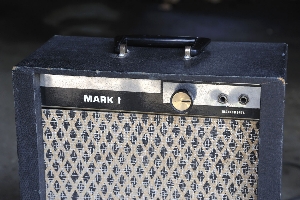 |
Here is a little closer view of the front panel. The only control is a volume control. I estimate output power to be around 5 watts or so. |
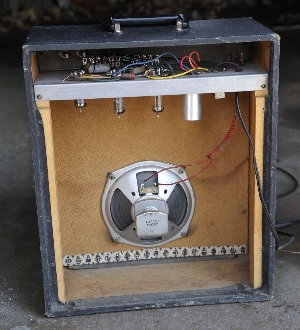 | Here is a rear view of the amp with back panel removed. |
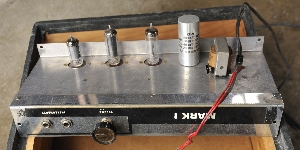 |
Here is the chassis removed from amp. The tube compliment is a 12AU6, 50C5 and 35W4. There is no isolation transformer, so it appears to have a "hot chassis". |
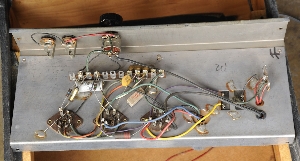
|
This is a view of the component side of the chassis. |
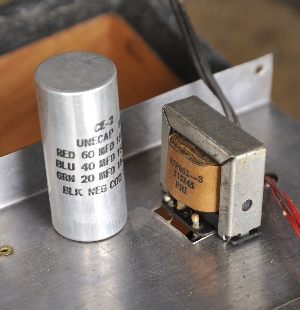
|
Here is the output transformer and filter caps. Click here for schematic. Click here for a page by Doug Garmon that shows how to add an isolation transformer to make this amp safer to use by today's standards. Thanks to Doug Garmon and Chad Gibson for the info on this model! |
Mark Two
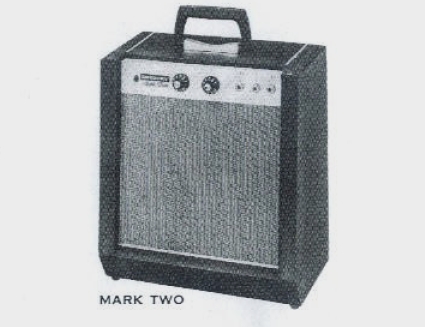 |
This is the Mark Two, a small combo amp that used a 35W4 rectifier tube, a 50C5 power tube and a 12AU6 input tube.
I do not know what size speaker it used, but it appears to have been a 4 ohm speaker per the schematic. I'm guessing that it used a 6" or an 8" speaker judging from the size of the
amp. A schematic for this amp was included in the brochure for the Mark Two and Mark Six. |
Mark V
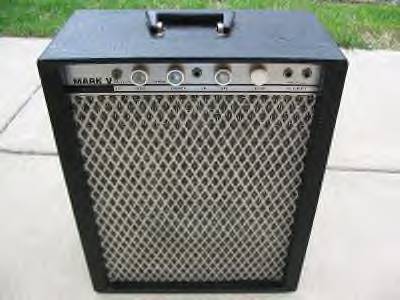 |
This is the Mark V, a 1x8 combo amp with tremolo. About 5 watts of output power. This example has an alnico speaker
and the schematic dates from Nov. 3, 1955. Being the Mark X's little brother, it's another very simple design with two inputs, and the same tremolo controls as the Mark X. |
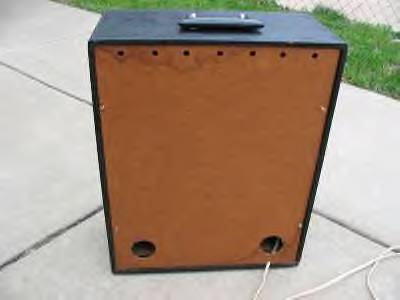 | Here is a view of the back of the amp - this one still has the back cover. Tube compliment is a 35W4, 50C5, 12AV6 & 12AU6. It appears to use a single ended circuit. One interesting feature of this amp is that it features a pentode input tube, which is unusual for a tube amp. Here is the schematic for this amp. |
Mark Six
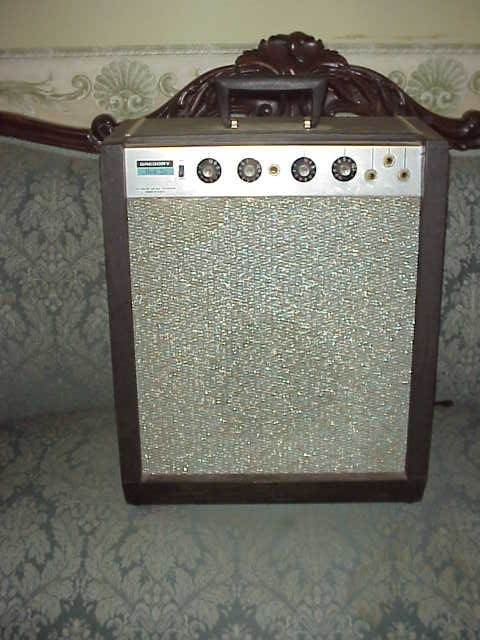 |
This is the Mark Six. It uses a 12AU6, 12AV6, 50C5 and 35W4 tubes in a very simple circuit which includes tremolo. The Mark Two is a sister amp to this one, using only three tubes and has no tremolo. |
 | Here is a partial view of the front panel. Here is a brochure for the Mark Two and the Mark Six, with schematics included. |
 | Here is the rear with the back cover removed. It appears to use an 8" speaker. |
Mark Eight (Original Version?)
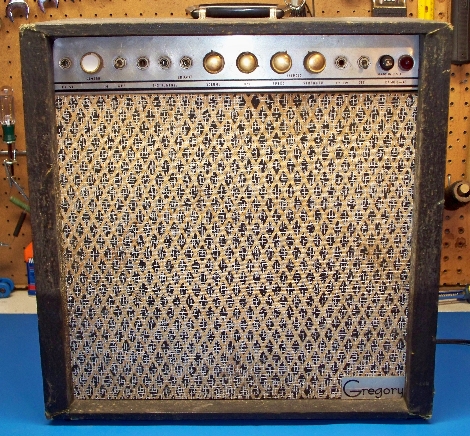 | I'm not 100% sure on this one, but I believe that it is the original version of the Mark Eight, but there are no markings to confirm that. It is so similar to the Mark Eight shown below that I am pretty sure that this must be the original version of the Mark Eight. This one is dated August 6, 1965. |
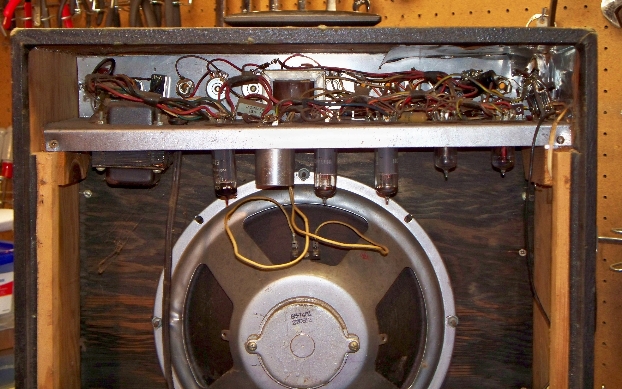
| This is the back of the amp with the panel removed. The speaker is a 10" Quam-Nichols.
The reverb on this amp is solid state, which is a little unusual for amps from this time period. Probably was a cost saving measure to inexpensively add
reverb to an existing circuit. Tubes are an EZ81 rectifier, a pair of 12AX7 preamp tubes and a pair of 6BQ5 (EL-84) power tubes. Click here to see a larger picture of the control panel. Click here to see a schematic for the solid state reverb circuit. |
Mark Eight
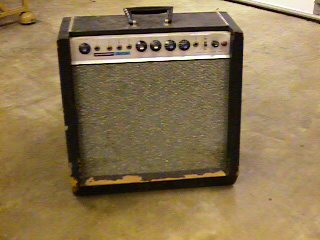 | I have no information on this amp at this time. I am guessing that it is a 1x12 combo similar to the Mark Six with tremolo and reverb, but I have yet to confirm the speaker size used. |
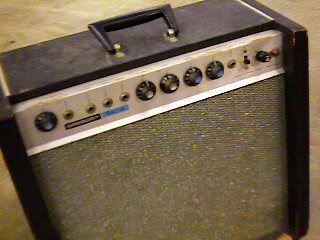 | Here is a little closer front view.Click here to see a larger picture of the control panel. |
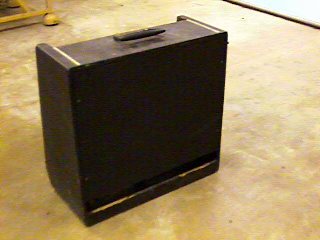 | This is the back of the amp. It has the usual bottom vented back cover that their combo amps used. |
Mark X
 |
This is the Mark X, a 1x12 combo amp with tremolo. About 10-12 watts of output power. |
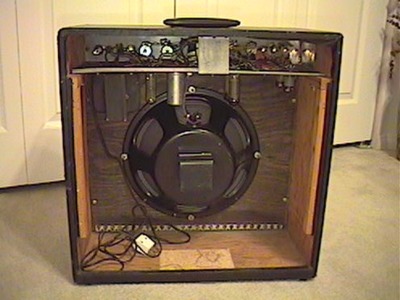 | Here is a view of the back of the amp. Tube compliment is a 6CA4/EZ-81 tube rectifier, a pair of 12AX7/ECC83s and a pair of EL84/6BQ5s. The speaker in this example is not the original speaker. Click here to see a another example of a Mark X. |
Mark Eleven
 |
This is the Mark Eleven, a 1x12 combo amp two-channel closed back combo amp with Hi-Z & Low-Z inputs on both channels, and tremolo. There is a jack for a foot switch to turn on/off the tremolo circuit. Probably has about 10-12 watts of output power. |
 |
Here is a view of the back. The three 12AX7A tubes are for (from right to left) tremolo, channel 1 and channel 2. That is followed by a pair of 6BQ5 output tubes. The Celestion speaker is obviously not original to the amp. |
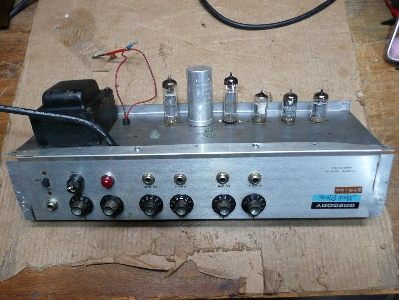 |
Here is the chassis removed from the amp. Uses the same folded metal sheet for a chassis like all other Gregory amps I have seen to date. |
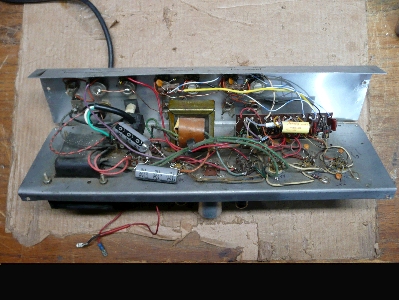 | Here is the inside of the chassis. It's the usual rat's nest wiring typical to these amps. Click here for a schematic of this particular amp (note that per the owner of this amp, it may have been changed from original factory wiring) Thanks to Warren Bendler for the information on this amp. |
Mark XV
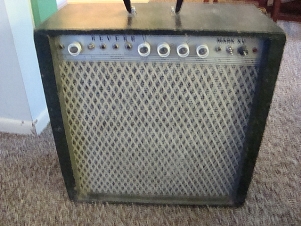 | This is the Mark XV, a 1x12 combo amp with tremolo and reverb. About 10-12 watts of output power. There is no Gregory nameplate on this example, but it is undoubtedly a Gregory amp. The schematic found inside the amp confirms that. |
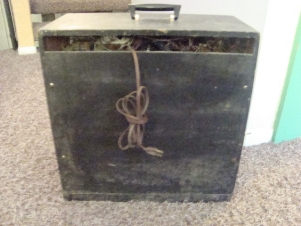 | Here is a view of the back of the amp. |
 | Tubes used are a 6CA4 rectifier tube, a pair of 12AX7s and a pair of EL84/6BQ5s. |
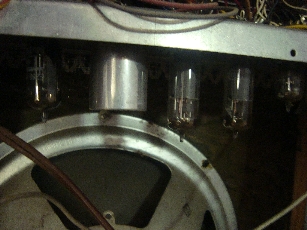 | The speaker looks to be the usual Quam-Nichols speaker used in most Gregory amps. The schematic for this amp can be found in the Reverb 900 section below. |
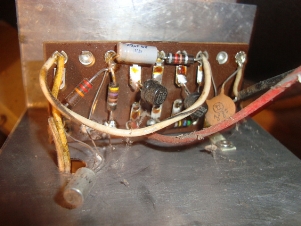 | Here is a picture of the solid state reverb circuit typically used in the Gregory amps which had reverb. Thanks to Eddie Lance for contributing the information on this amp. |
The "Mark Sixteen"
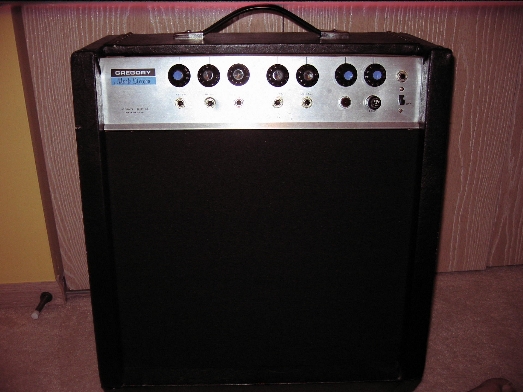 | Here is the "Mark Sixteen". The owner of this amp has had it in his possession for other thirty years. Notice the similarity to the "Tiger Amp" outlined below. |
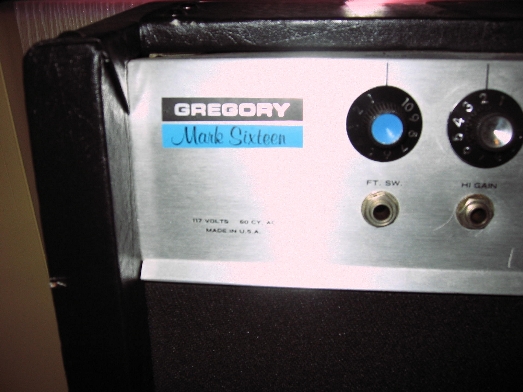 | The Mark Sixteen graphics on the left front panel. These models look far better cosmetically than the earlier Gregory amps do. I do not know for certain if this has the original cabinet covering and grillecloth. |
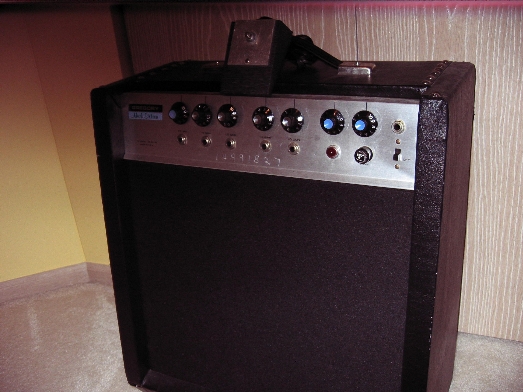 | There are several controls and jacks on the front, but I do not currently know what they all are - the controls are marked on the top of the chassis where I can't see them in these pictures. |
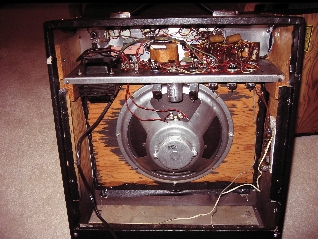 | Here is the back of the amp. It uses three 12AX7 preamp tubes and a pair of 6BQ5/EL84 power tubes. It has a reverb tank, with what appears to be a solid state reverb send/return circuit. The absence of a rectifier tube leads me to believe that it uses a diode bridge rectifier. Another example I have seen has a slightly different tube arrangement than what is shown here. |
 | Here is the reverb pan. Manufacturer of reverb pan is unknown. Speaker is a Quam-Nichols, which is consistent with every stock Gregory amp I have seen to date. |
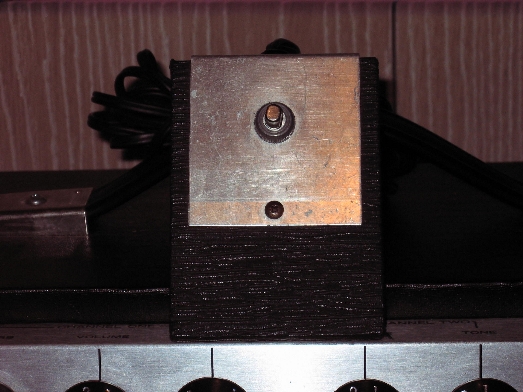 | This is the footswitch that goes with the amp. (Special thanks to Carl Reese for providing these pictures!) Click here to see a similar amplifier. |
Mark XX
 | This is the Mark XX, what appears to be a 2x12 combo amp with tremolo. This basically looks like a Mark X with two speakers but has two channels, and I would guess that it also has about 10-12 watts of output power. |
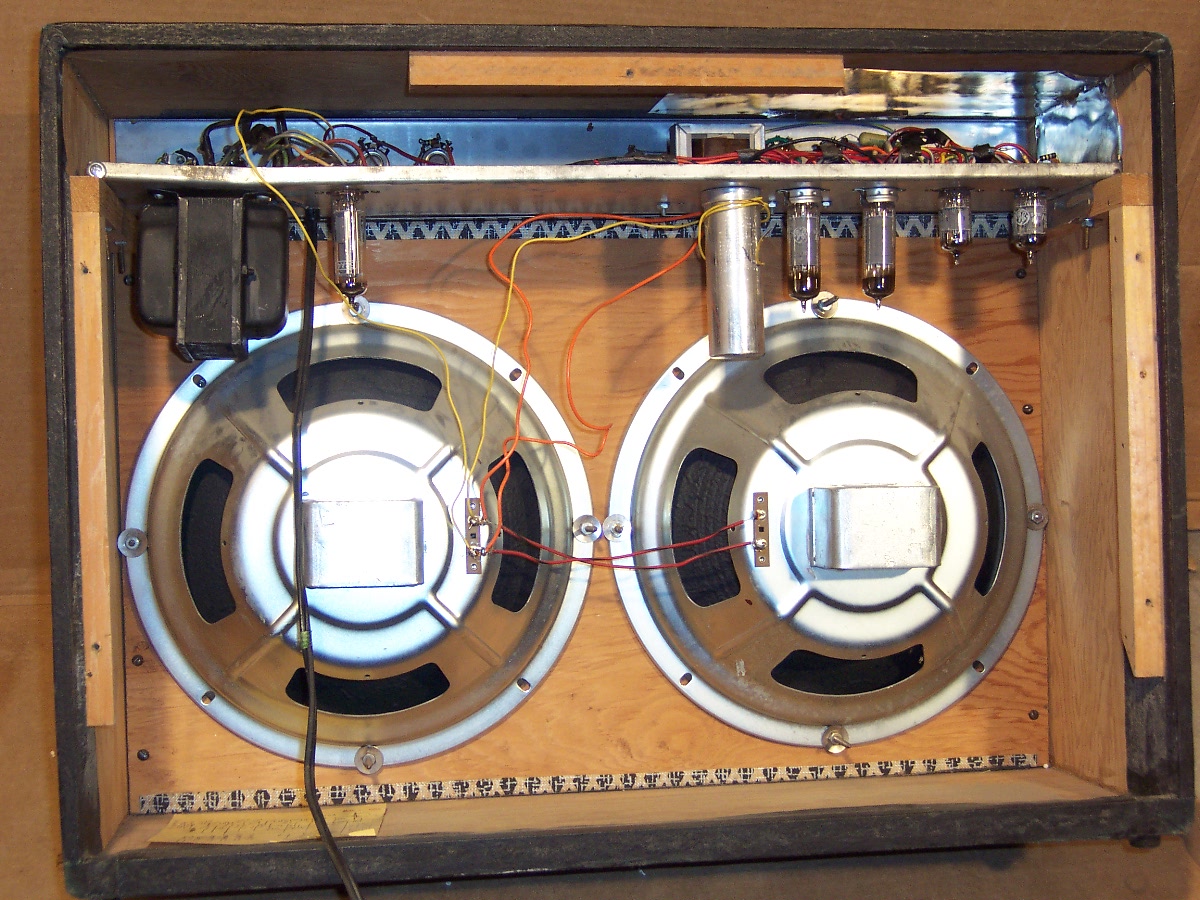 | Here is a view of the back of the amp. I believe that the tube compliment the same as the Mark X - a 6CA4/EZ-81 tube rectifier, a pair of 12AX7/ECC83s and a pair of EL84/6BQ5s. |
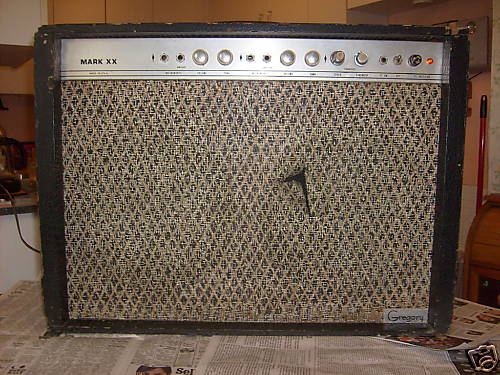 | Here is what appears to be a later version of the Mark XX. Click here to see the schematic for the Mark XX. Click here to see a radically different example of the Mark XX from the two different examples shown here. |
Mark XXV
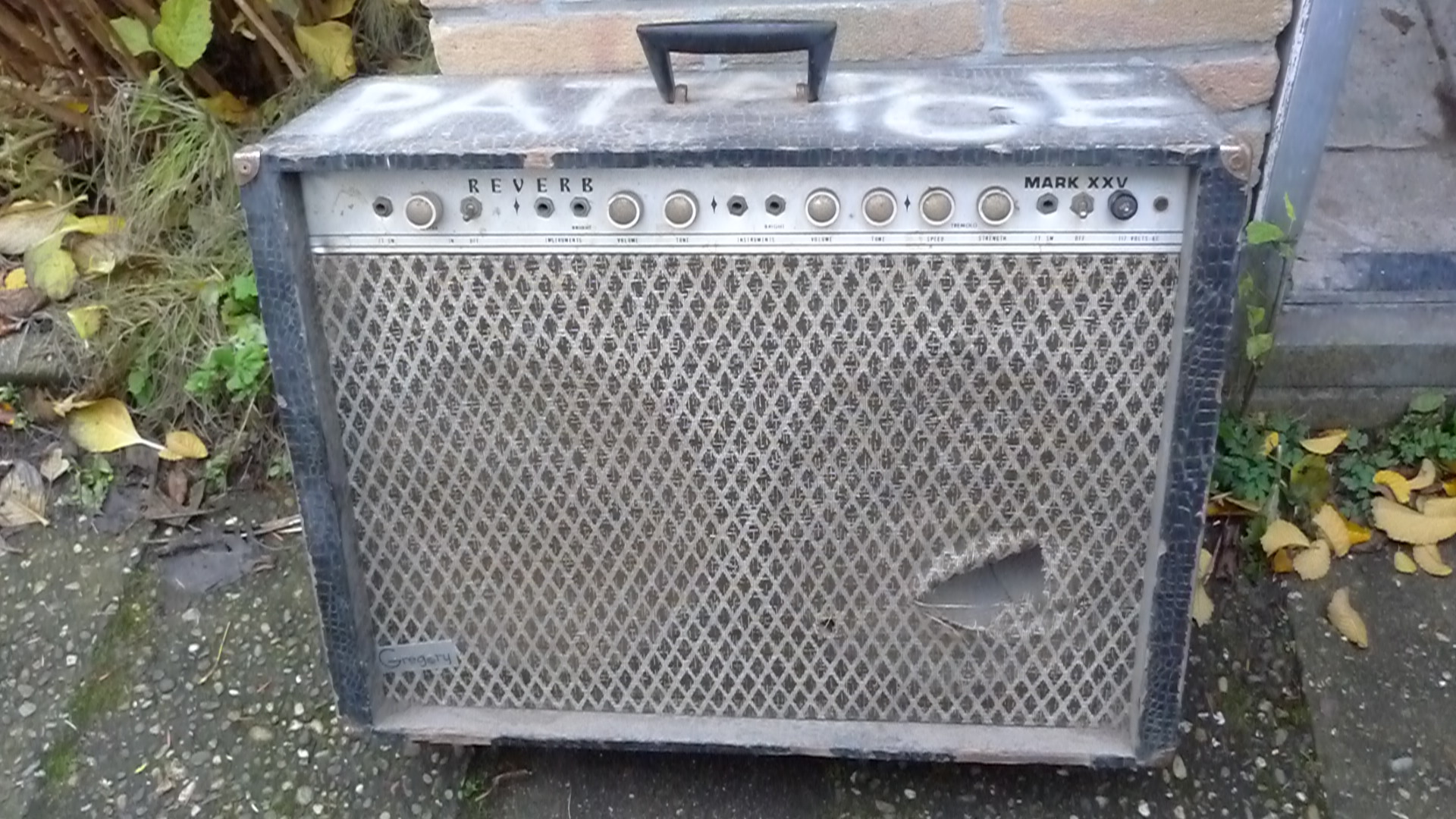 |
This is the Mark XXV, which appears to be a another 2x12 combo amp with tremolo AND reverb. I'm guessing that this also has about 10-12 watts of output power. |
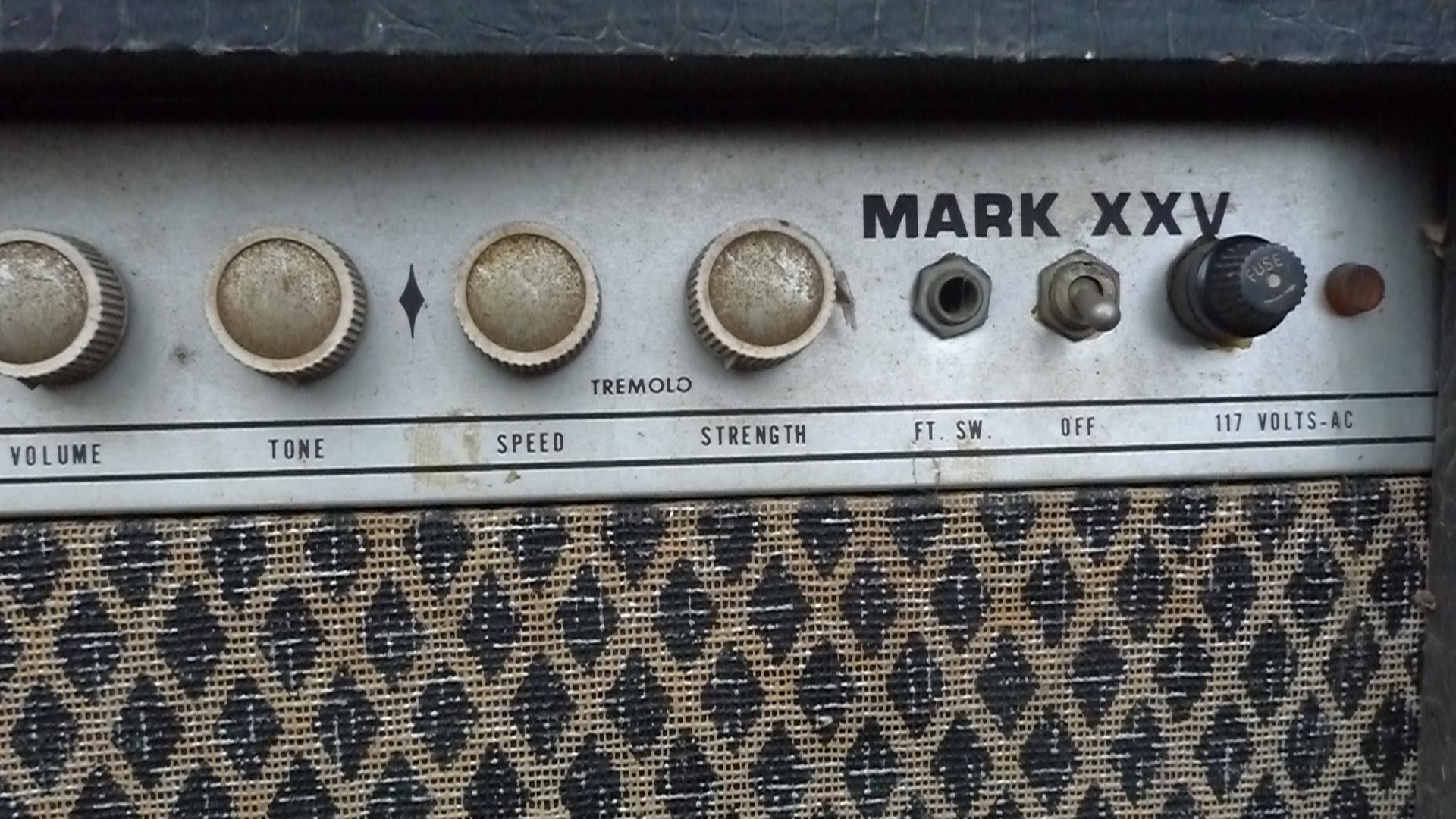 |
Close up of name on faceplate. This looks like it might have been the forerunner to the Reverb 1500 model, and probably uses the same tubes. Thanks to Feddo Renier for the pictures. |
 |
This is a second example showing the two speakers. I believe they are alnico type made by Quam Nichols. |
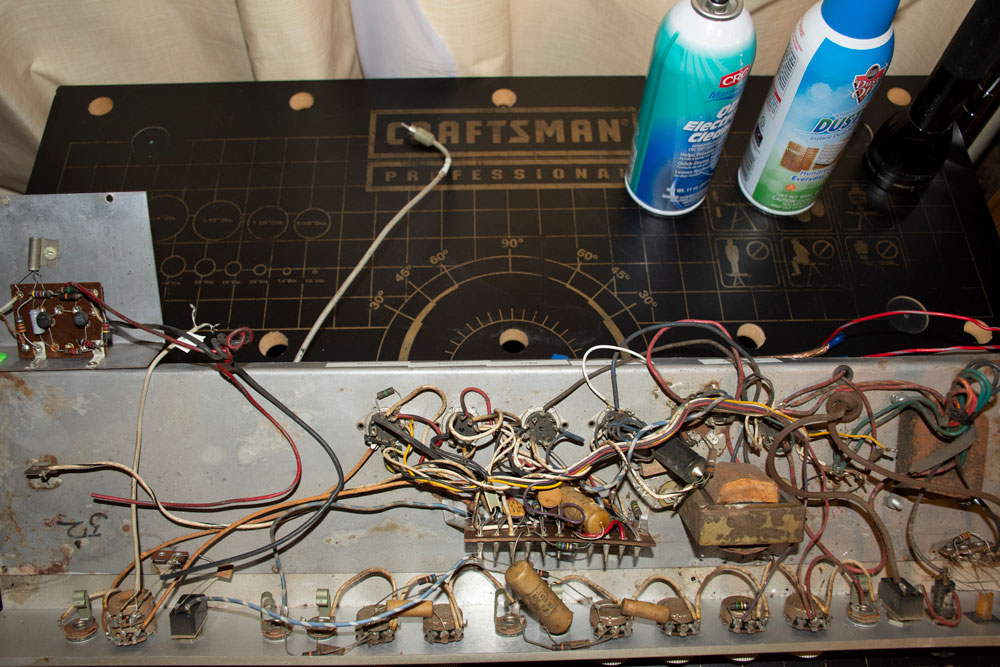 |
Here is the chassis removed which exhibits the same rather sloppy wiring typical in Gregory amps. The tube compliment is (2) 12AX7s, (2) EL-84/7189 power tubes and a EZ81/6CA4 rectifier tube. This amp utilizes the solid state reverb circuit (at upper left) and a Hammond reverb tank. |
Mark XXX
 | This is the Mark XXX bass amplifier. It has one 15" speaker. It appears to use the same tubes as the Mark X - a 6CA4/EZ-81 tube rectifier, a pair of 12AX7/ECC83s and a pair of EL84/6BQ5s. Output power is probably around 15 watts. Click here for schematic. |
Mercury 600
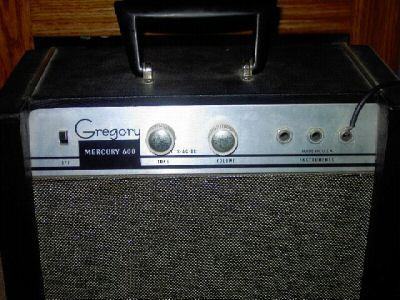 | Very basic guitar amp with just a volume and tone control. Not sure of the wattage, but the tubes used are a 12AU6, a 35W4, and a 50C5. Apparently, this amp uses a transformerless design - kind of like the power scheme found in old radios, which poses potential safety hazards. The tubes also do not sound like they are easily replaced. It appears to use a 6" speaker of unknown origin. It will overdrive very easily from what I have been told. |
Gemini 700
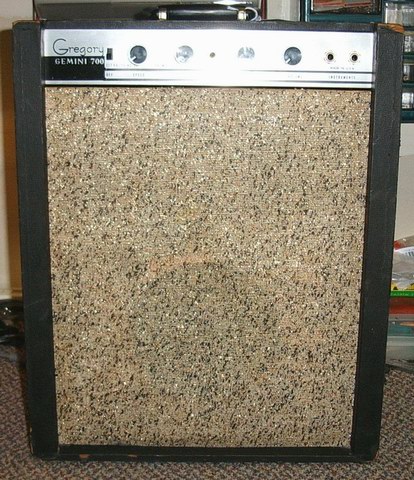 | This is the Gemini 700 amp. Tubes used are a 12AU6, 12AV6, 50C5 and a 35W4. One interesting feature of this amp is that it features a pentode input tube, which is unusual for a tube amp. Here is the schematic for this amp. |
Apollo 800
 | This is the Apollo 800, a 1x12 combo amp that is similar to the Mark X. This one has seen some action! (thanks to Tim Gagan for contributing these pictures) |
 | This a little closer view of the controls. The knobs are replacments. |
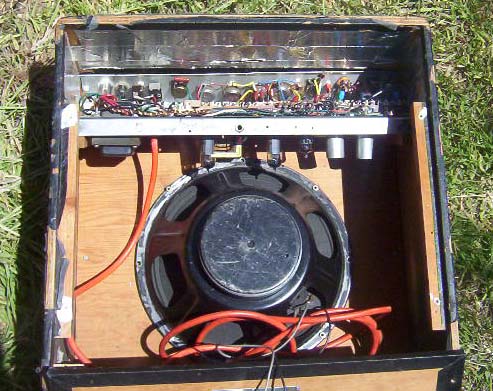 | This is the back of the amp. From this view, it looks very similar to the Mark X. |
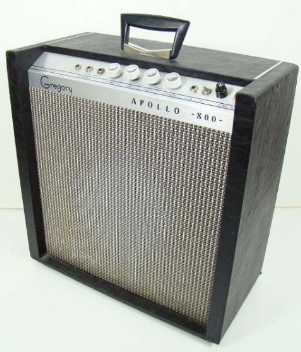 | This is a pristine example of an Apollo 800, but it appears to be different from the example shown above because there are less control knobs on it. I believe that the example shown above has been modified from the original. |
 | Left side of control panel. |
 | Right side of control panel. The condition of this example is amazing compared to all of the other Gregory amp models I have seen. |
Reverb 900
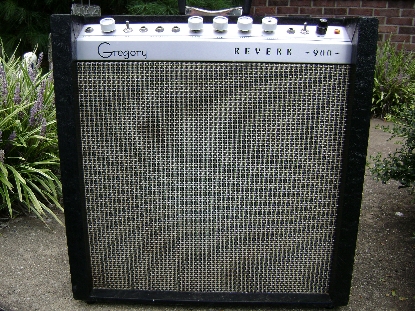 | This is the Reverb 900, which appears to basically be an Apollo 800 with reverb. This is also a 1x12 combo amp. This one has spent most of its life in storage, so it's in very good condition after being bought new way back in 1966. |
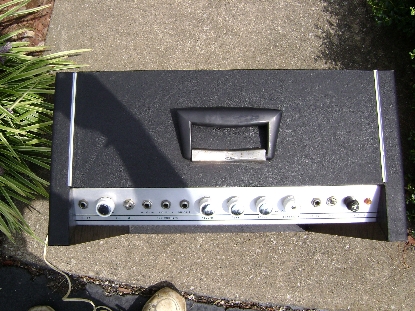 | This a view of the top of the amp showing the controls. |
 | This is the back of the amp. The tubes used in this amp are a 6CA4 rectifier tube, a pair of EL-84 power tubes and a pair of 12AX7 preamp tubes. The speaker was made by Quam-Nichols, which appears to be the brand used in most of the Gregory amp models offered. Here is the schematic for this amp, which apparently also applies to the Mark X, Mark XV & Apollo 800. Thanks to Allen V. Graf for contributing the pictures and info on this model! |
Atlas 1000
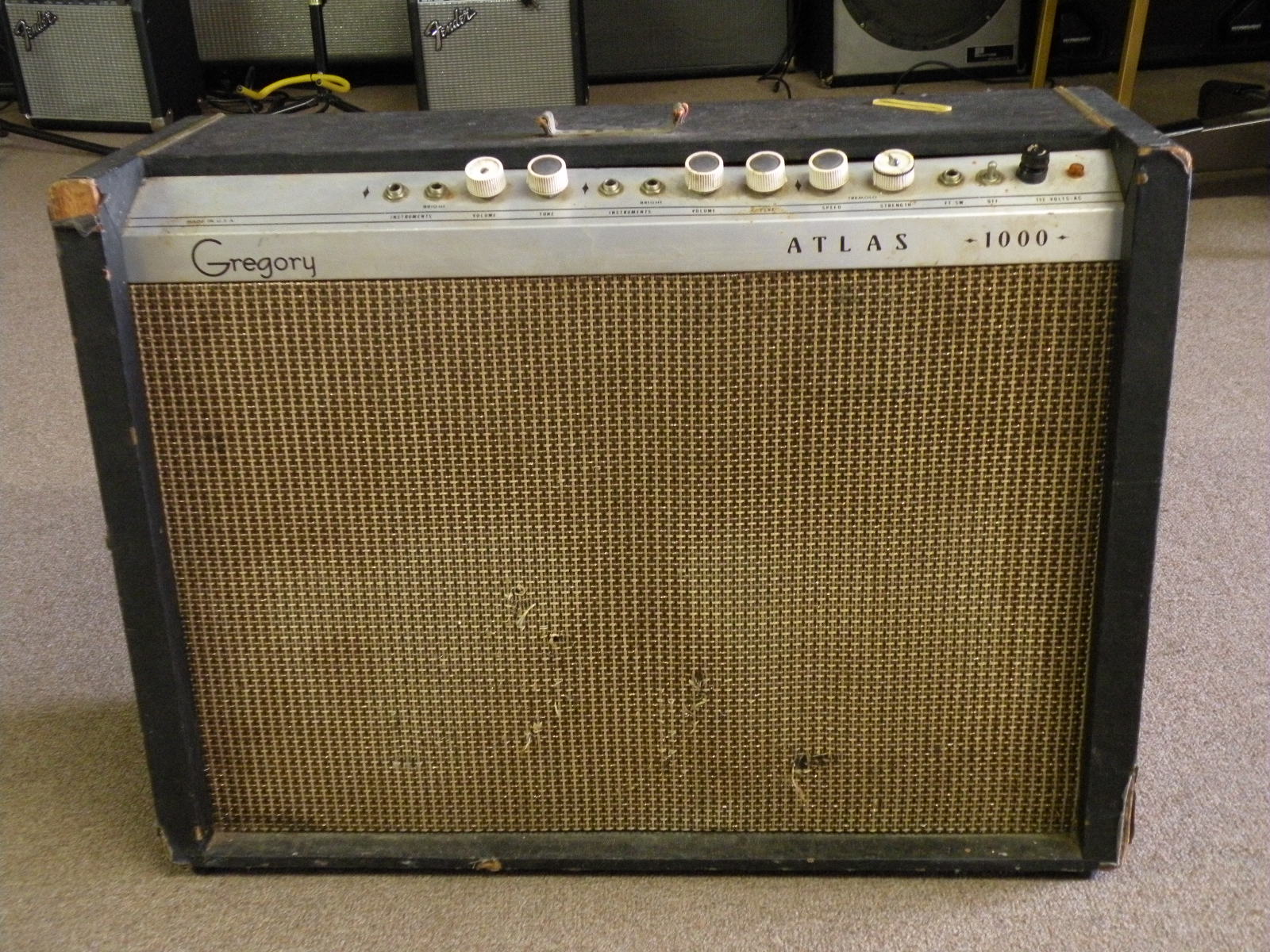 | This is the Atlas 1000, a 2x12 combo with tremolo. This example dates from 1965-66. Controls are as follows: the first channel [left] has Volume and Tone controls. The second channel has Volume, Tone, Speed, and Strength. I believe this was probably originally designed to be a 25-30 watt amp. |
 | Left side of control panel. Notice the similarity in appearance to the Apollo 800 and Reverb 900 models. |
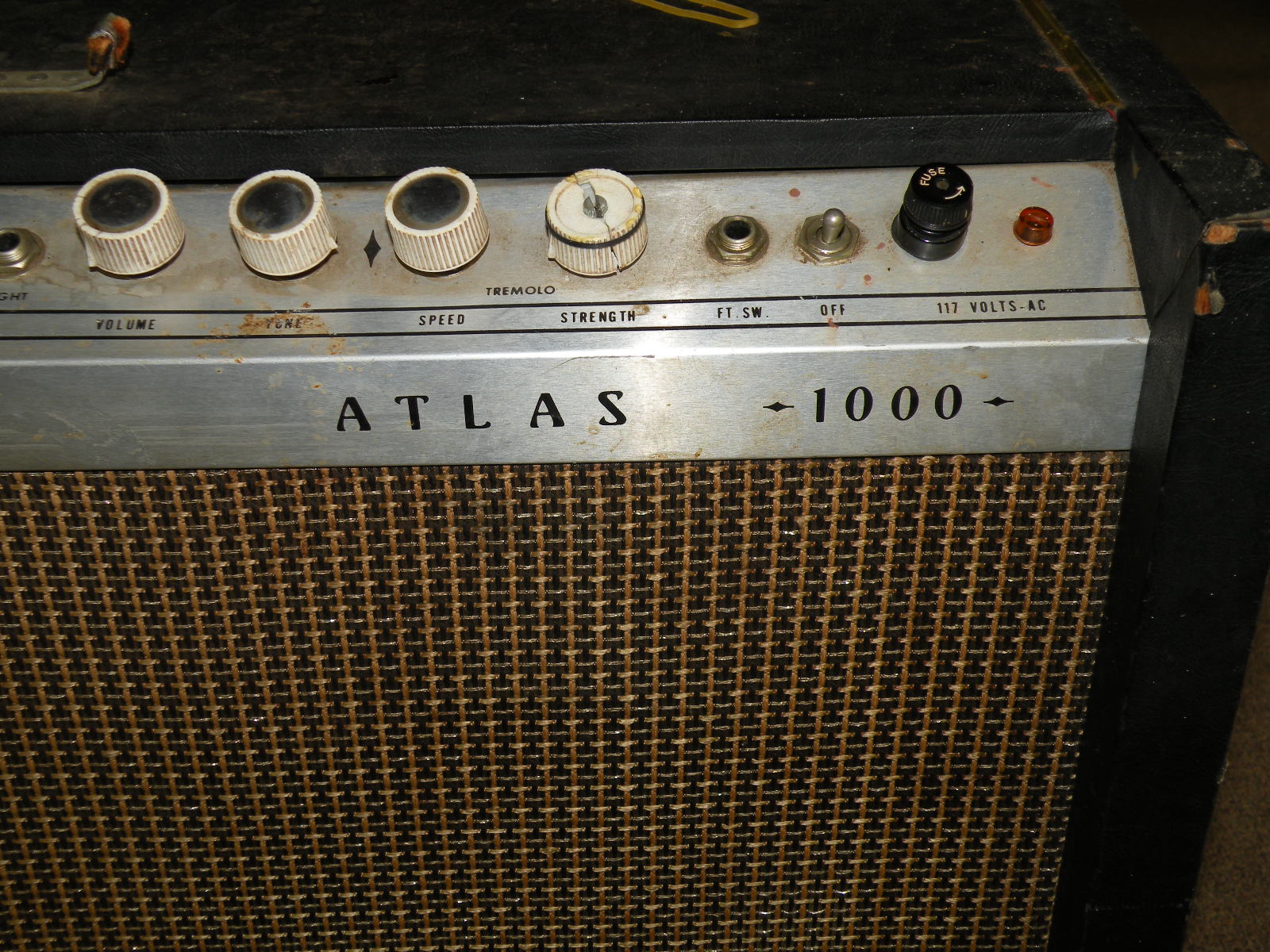 | Right side of control panel. Grille cloth is the same as what you would find on the Apollo 800 and Reverb 900 models. |
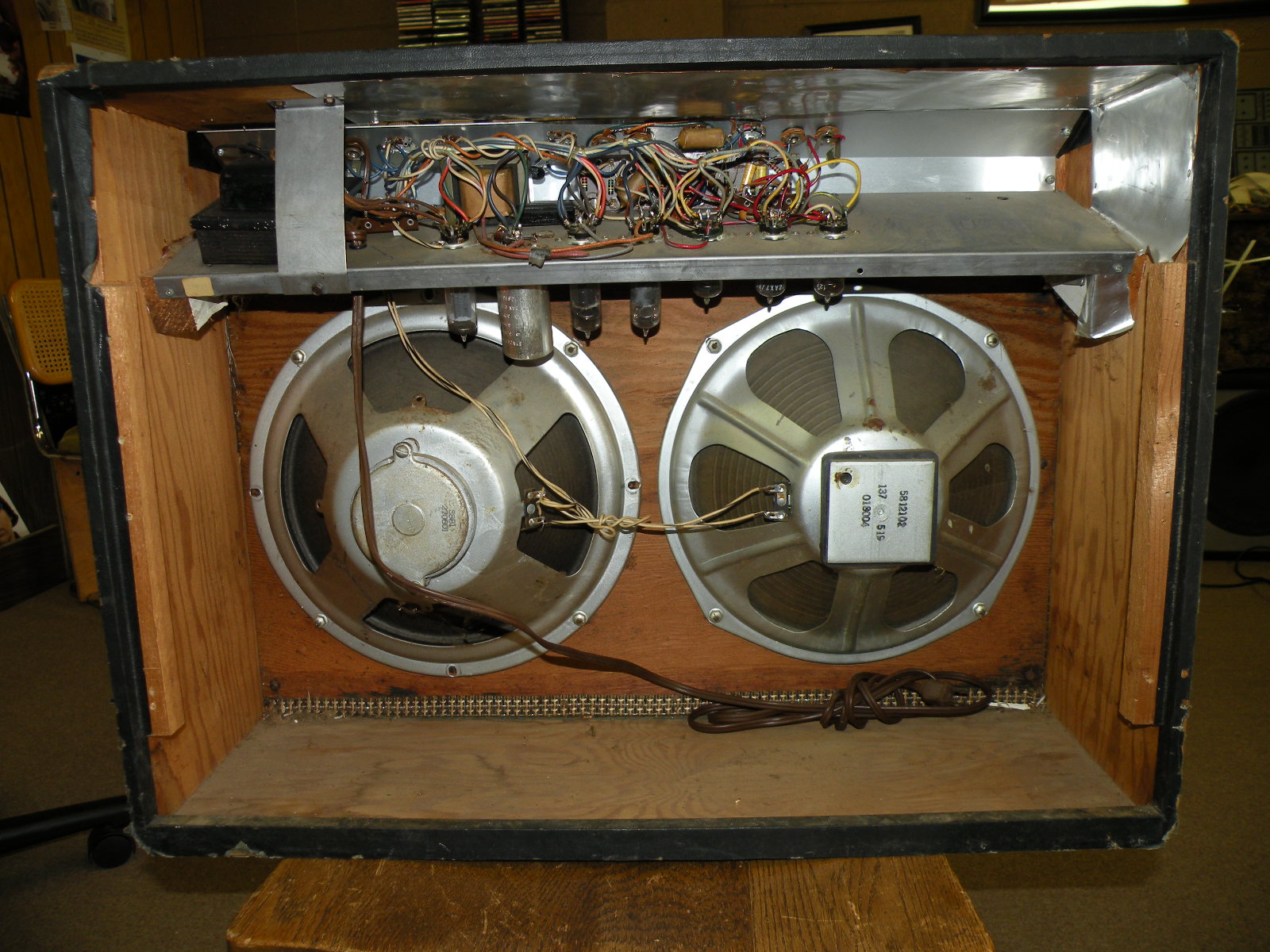 | Here is the back of the amp with the cover removed. The tubes used are a 6CA4 rectifier, a pair of 7189 power tubes and three 12AX7 preamp tubes. The speakers look mismatched. I have seen other Gregory combo amps with two different speakers in them, so I am thinking that maybe they did this on purpose for some reason. Notice that the Reverb 1500 shown directly below has the same speakers in the same place. |
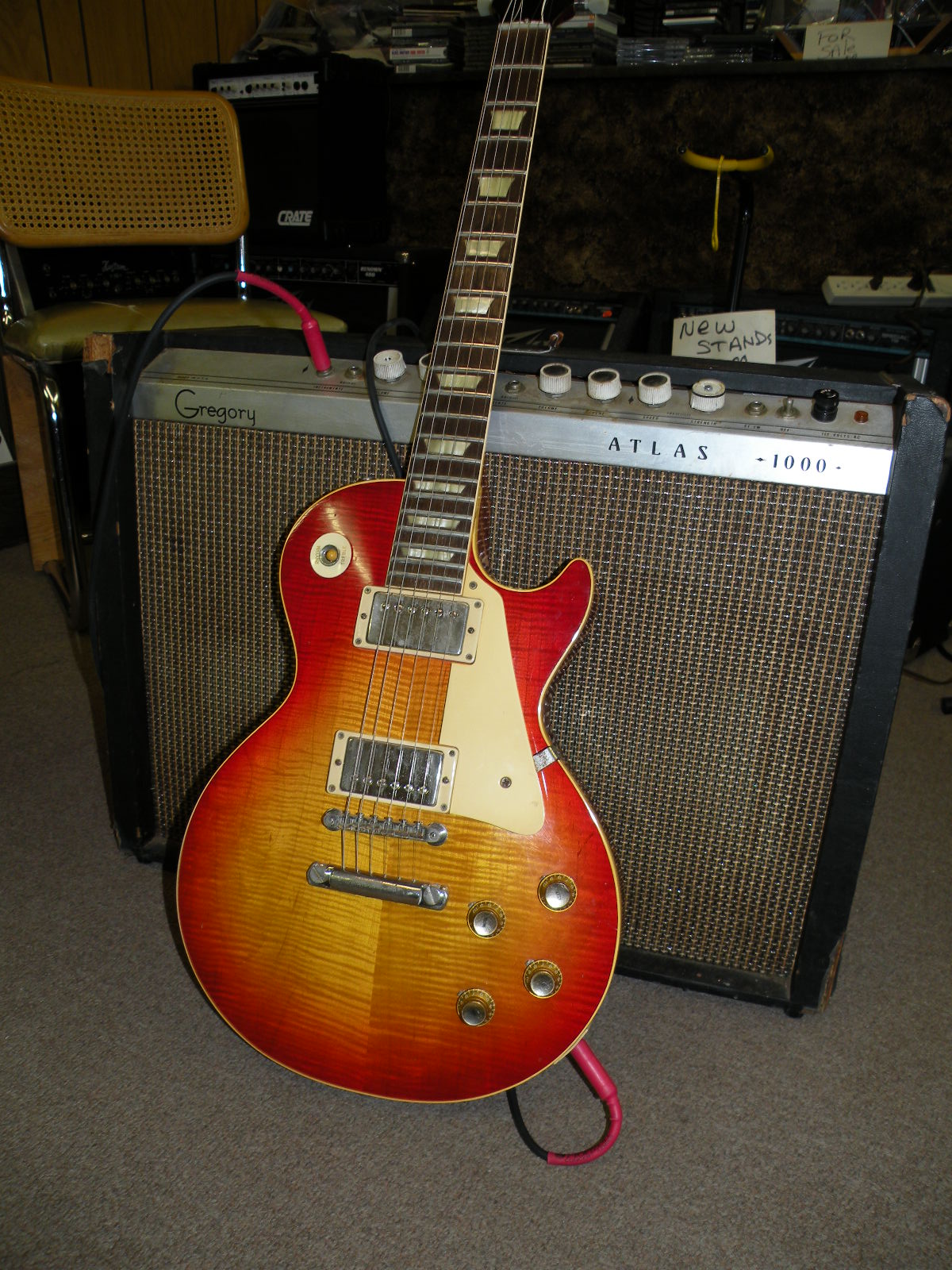 | You might have seen a 1960 Les Paul like this one leaning up against this amp when it was new. Special thanks to Tom Wittrock for the info provided on this model! |
Reverb 1500
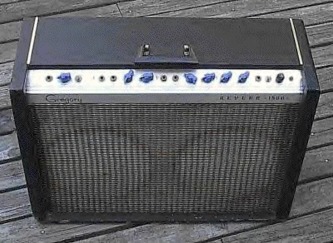 | This is the Reverb 1500, which appears to be a two-channel combo amp something like a Fender Twin Reverb. It looks like it is basically a two-speaker version of the Reverb 900 amp, or more likely an Atlas 1000 with reverb added. |
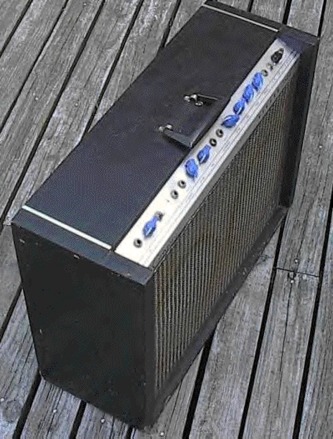 | Here is a view of the top of the amp. Not sure of the control layout. I am pretty sure that those are not the original knobs. They should be white ones like the ones on the Apollo 800, Reverb 900 and the Atlas 1000. |
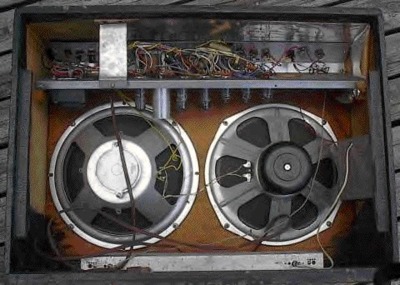 | This a view of the back of the amp. The chassis construction in this amp is very similar to the Mark X. This appears to be a 2x12 combo. At first I thought that this example had a replacement speaker in it, but the example of the Atlas 1000 shown directly above has the exact same speakers in it, in the same place. Seems to be more than just a coincidence. Click here for a schematic of the preamp section. Click here for a schematic of the reverb circuit. Click here for an analysis of the circuit by an amp tech with 20 years of experience. Special thanks to David Anderson for alll of the schematics and information about this amp! |
Bass 5000
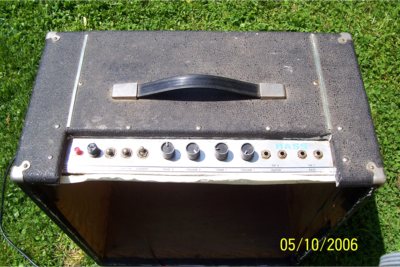 | This is the Bass 5000 bass amplifier. It has one 15" speaker. |
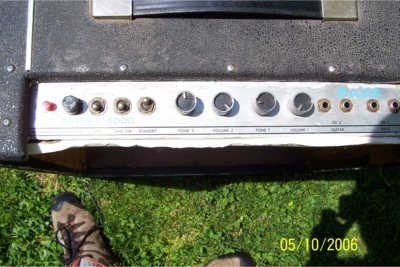 | Here is a little closer view of the controls. (thanks to Steve Prange for contributing these pictures) | 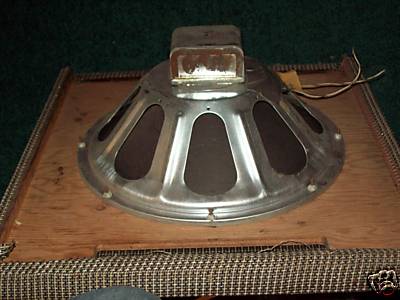 | This is the 15" speaker mounted on the speaker baffle, which has been removed from the amp. | 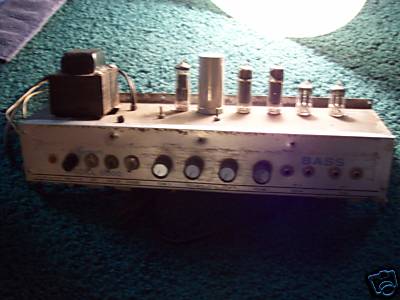 | Here is the front of the chassis. |  | This a view of the inside of the chassis. The wiring in this amp looks very messy. |
Tiger Amp
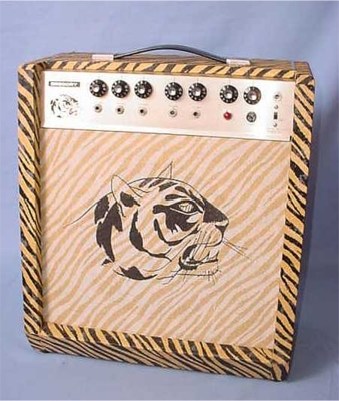 | This is a very unusual but kind of cool looking (and good sounding) 10-15 watt amp from around 1968. From what I can gather, this similar to a Mark X, but with reverb and two channels. No idea on the exact dates of manufacture, but I would guess it's from the late 60s or early 70s. One person emailed me saying he had documentation for one of these amps from 1967, so it would appear that my guess was right on. (Thanks to Stacey R. for contributing these pictures) |
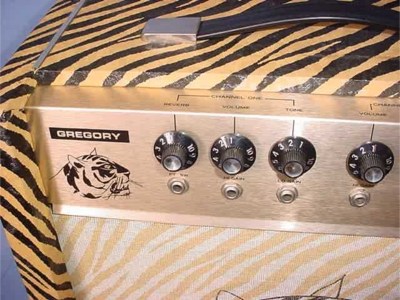 | This is the left side of the control panel. Channel 1 has reverb (foot switch controlled on/off), a volume and tone control, with high and low gain inputs. Channel 2 has tremolo, adjustable for rate & depth (foot switch controlled on/off), a volume control and tone control, also with high & low gain inputs. |
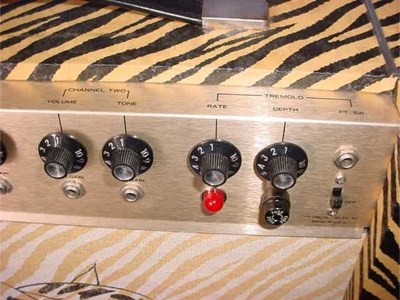 | Right side of the control panel. This amp looks very much like the Marie Sixteen model, especially when looking at the chassis. |
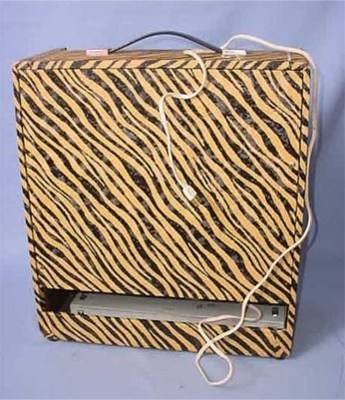 | This is the back of the amp. From this view, it looks very similar to the Mark X. The reverb tank can be seen at the bottom of the enclosure. |
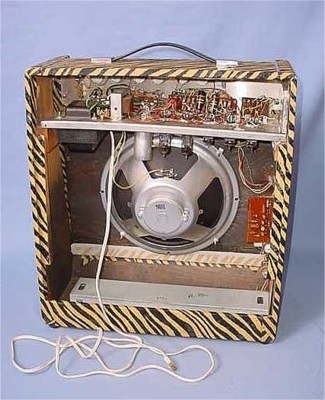 | This is the back of the amp with the cover removed. This follows the typical construction of these Gregory amps. One 12" speaker which appears to be original. The speaker manufacturer on this example is Quam-Nichols. |
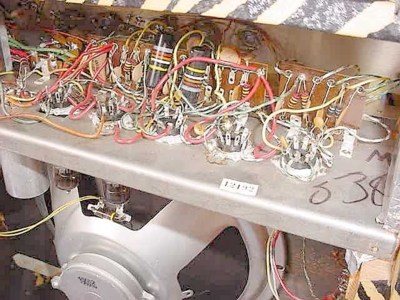 | Here is a closer view of the chassis. This amp uses stripboard construction instead of terminal strip style point-to-point wiring seen in the earlier Gregory amps. |
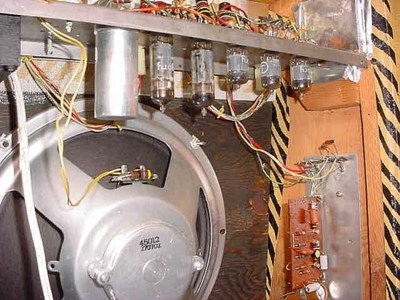 | The tubes used are a pair of 7189 (EL84) power tubes, and three 12AX7s. What is really unusual is that the "Gregory" logo has been printed on these tubes. It appears that this amp uses a solid state rectifier since a rectifier tube is conspicuously absent. To the right of the speaker appears to be the reverb circuitry. The owner of this amp has said that it is a super sounding amp, and that it would also make a great harp amp, too. Click here to see a similar amplifier. |
Handi Amp
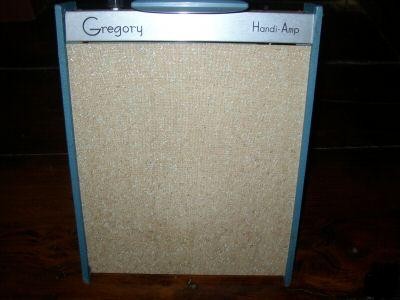 | This is the "Handi Amp", which can be either battery powered or plugged into a 120VAC source. I don't have really have any more data on this one than that. |
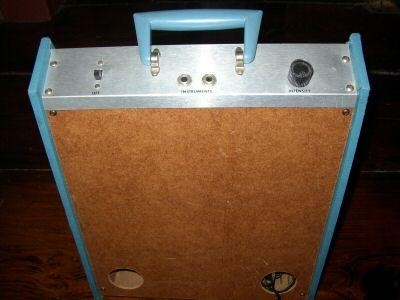 | This is the back of the amp. |
The "Two Fifty"
 | Here is yet another model from Gregory. This one is called the "Two Fifty" and appears to be a small practice amp. |
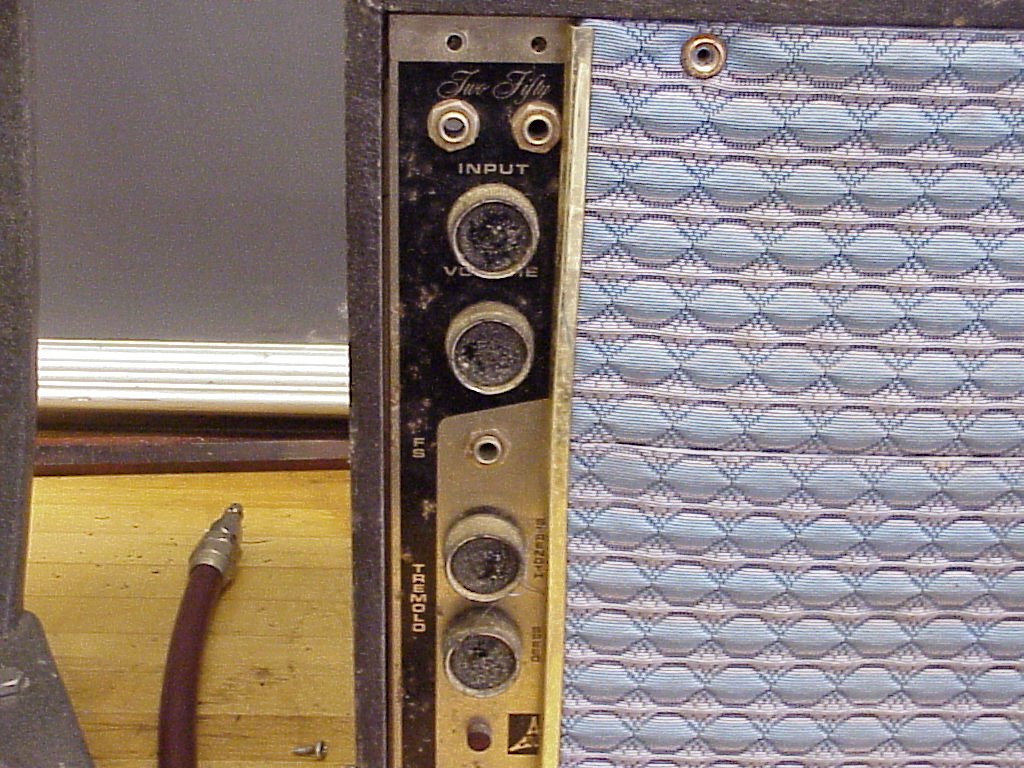 | This is closer view of the front panel. There is a volume control, tone control and controls for the tremolo. Not sure of the date of manufacture, but I would guess late 50s/early 60s. |
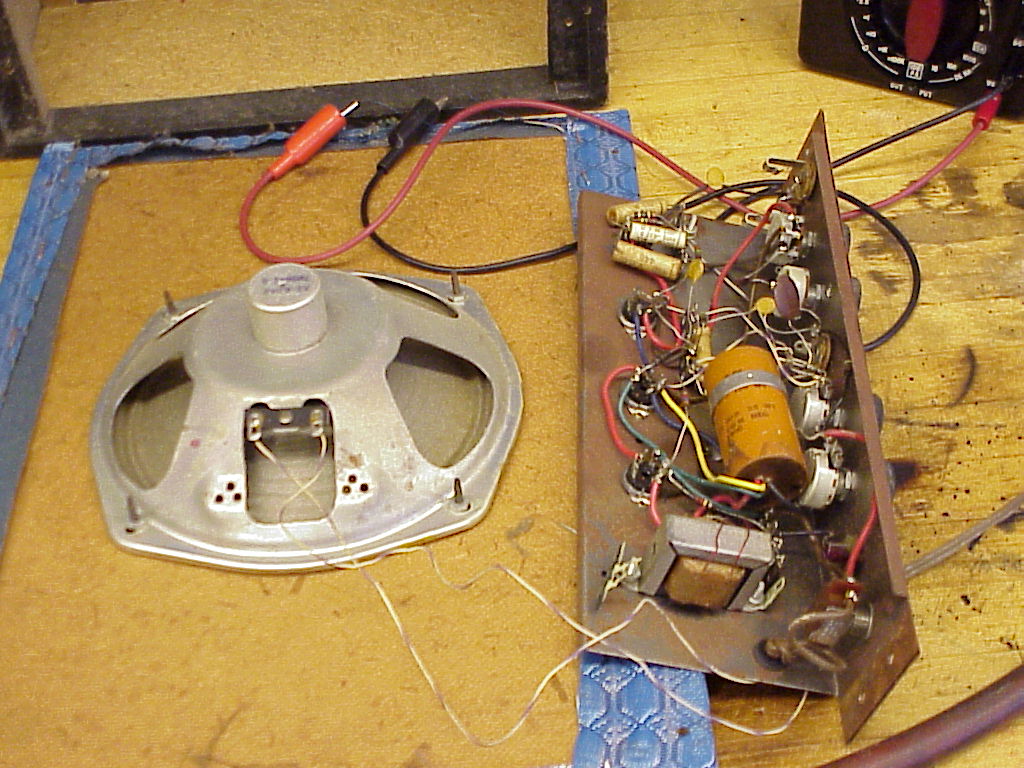 | This is the chassis. This amp has no power transformer, only an output transformer. This example appears to have used three tubes. I have heard of one example that used four tubes - a 35W4, a 50C5 and a pair of 12AV6s. A 12AV6, which is a double-diode triode, is a very unusual preamp tube for a guitar amp. This model appears to have used an 8" speaker, but it could possibly be 6" speaker. |
The "007" (Tube Version)
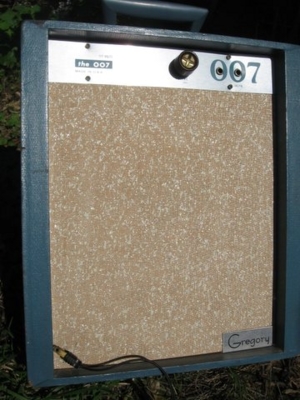 | Here is another amp that looks like it was intended to be a practice amp or a cheap beginner's amp. Tubes used are a 12AU6, a 50C5 and a 35W4. I would guess this amp to be around 5-7 watts. One control: volume, which also happens to have a switch built in it - pull it out and the power comes on. |
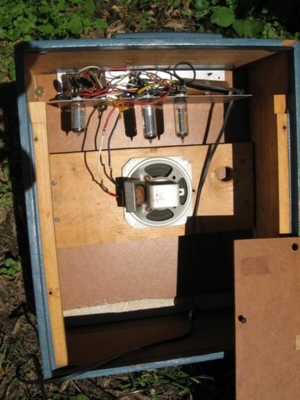 | This is the inside of the amp with the back cover removed. The speaker is mounted on a piece of pine that the current owner installed in the enclosure. The speaker is an alnico type and looks to be about 6" or so. Notice that output transformer is attached to the speaker frame instead of the chassis. A little unusual, but I guess it was in order to use the cheapest possible chassis by constructing it out of the thinnest possible material. Thank you Marshall H. & James Arakaki for providing these pictures and info. |
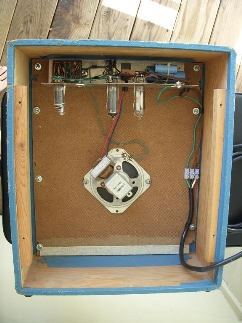 | This is an original 007 model with no modifications done to it. It looks like the speaker baffle would vibrate and/or rattle very easily since the material it is mounted on is so thin. |
 | This is a little closer view of the chassis. About a simple as it can possibly get. |
The "007" (Solid State Version)
 | This is what appears to be a later version of the "007", which has been apparently converted from the original tube design to a solid state design. I'm guessing this from the late 60s or very early 70s when solid state amps were the new craze. |
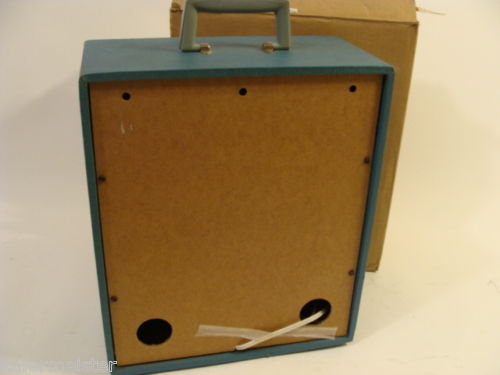 | This is the back of the amp. |
Twenty One A
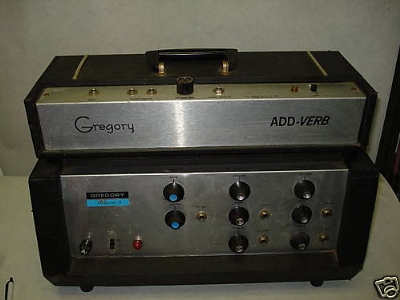 | This model is very similar to the Twenty Two A amp head. I think it's basically the same amp as the Twenty Two A, but without reverb. Controls are as follows: Rate, Depth, Volume, Bass, Treble. I'm not sure if both channels have vibrato or not. There is also a Hi Gain input and a Low Gain input for each channel. In this picture, there is also a stand-alone reverb unit called the "Add-Verb", which is another Gregory offering I didn't know about before. It has a Microphone input, Instrument input, a Reverb Mix control and Footswitch jack. I'm not sure if it uses tubes or not. | 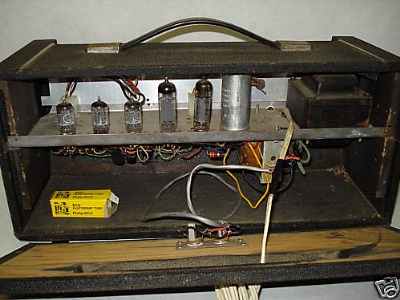 | Here is a view of the back with the cover removed. |
Twenty Two A
 | This is an amp head using another very simple design with two channels - bass and treble controls for each channel, along with tremolo and reverb. It is wired point-to-point and uses an AB push pull circuit. There are references to a 20A head and a 22A head on the internet, so I am not sure if they are two different models or the same amp. Both user reviews appear to be describing the same amp. Perhaps one day I will find the answer to that question. | 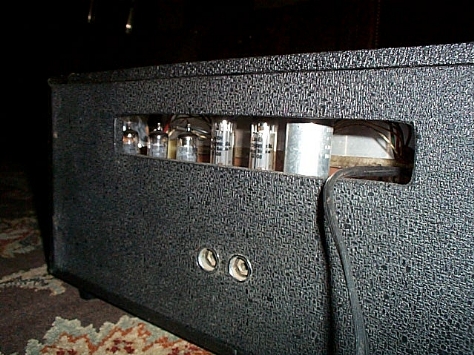 | Here is a view of the back. This is starting to look more like a conventional amplifier compared to their earlier models. |  | Tube compliment is a pair of EL84s and three 12AX7 preamp tubes. The power section is made up of two EL84s and a 12AX7 phase inverter. The preamp section uses a one side of a 12AX7 for each channel. The tremolo uses half of a 12AX7, and the reverb is reportedly solid state. Another description states that it uses a solid state rectifier. Output power is probably around 15 or watts. Thanks to Brinkley Issacs for the pictures! |
Bass Sixty A
 | This is an all tube head with two EL84s and two 12AX7s. There are two channels. Each channel has a volume, bass, and treble control and and a high and low gain input. Output power is probably around 15 watts. | 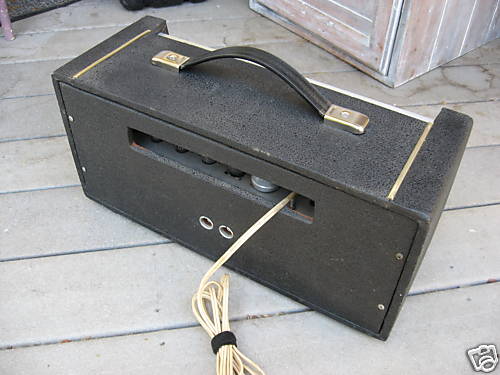 | Here is a view of the back. | 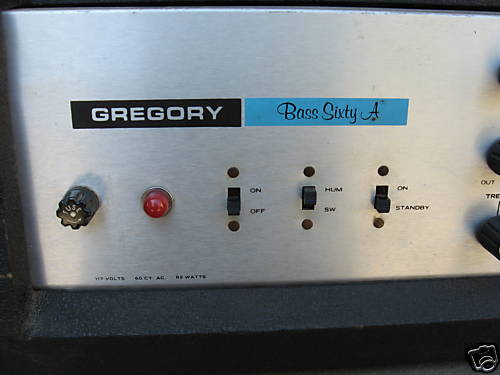 | Left side of control panel. Power switching is done with slider switches on this particular amp. |  | Right side of control panel. This example appears to have the original knobs. | 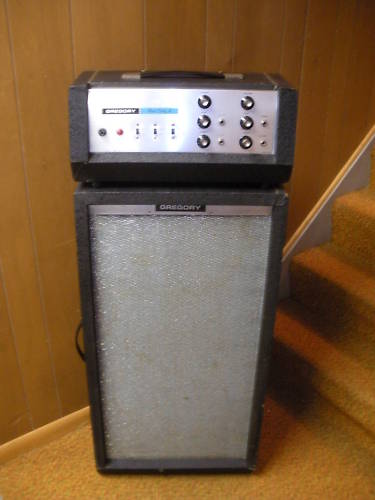 | Here is an example with a speaker cabinet. |
Saturn 80
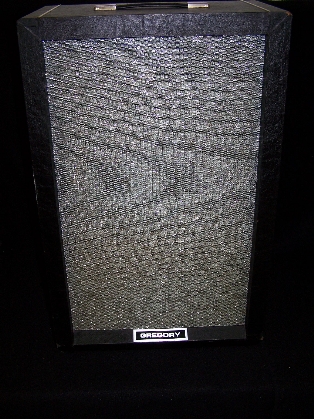 | Here is another unusual amplifier that was made by Gregory. This model appears to be what was intended as part of a PA system of sorts. The owner of this amp says it sounds really good. |  | Here is a view of the back. Notice the speaker enclosure vents at top and bottom. |  | Here it is with the back panel removed. Notice the chassis between the pair of 12" speakers and the smaller speaker at upper left. |  | Here is a closer view of the chassis controls. From left to right: there is a "HUM" switch, "ON" switch and a "STANDBY" switch. There are jacks marked "AUX. SPKR.", "INTER-SATURN CONNECT" and "C.I.A. INPUT". The knobs are simply a volume and tone control. Next to that is a "HI GAIN" and "LO GAIN" inputs. Tubes are four 7189s and two 12AX7s. Tubes are marked "Gregory" and were made in West Germany. Output power would appear to be about 80 watts. | 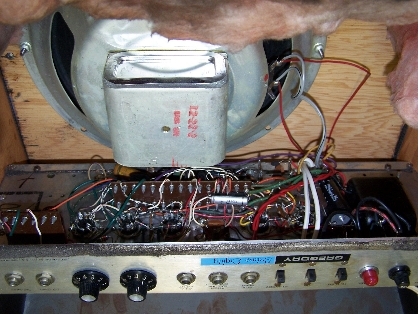 | This is a closer view of the chassis interior. Not sure who the speaker manufacturer was. It does not appear to be the usual Quam-Nichols speaker that you typically see in Gregory amps. Thanks to Doug Lehman for contributing the information on this amp. |
Mr Show Biz
 | Here is one of the more unusual offerings from Gregory, the "Mr Show Biz". What makes this amplifier interesting is that it also had a record player built into it. Kind of like an early karaoke machine of sorts and was listed in the 1966 Gregory Amplifiers catalog. | 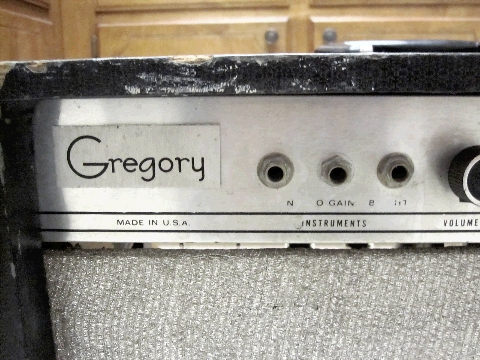 | Here is the left half of the control panel. It has three instrument inputs, like many other Gregory amps. |  | Here is the right half of the control panel. It has a tone control, and a tremolo with speed and strength controls. | 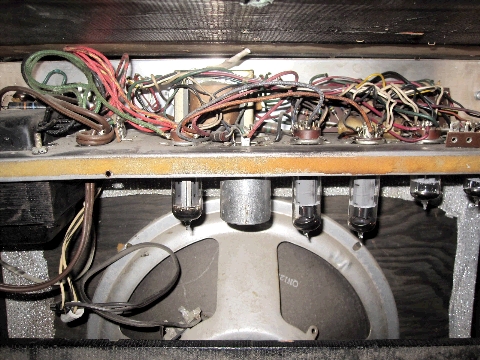 | The chassis is typical Gregory amps style. The power transformer had extra taps for powering the built-in record player. It has a 6V4 rectifier tube, a pair of 12AX7's and a pair of 6BQ5 (EL-84) power tubes. There were terminal posts that connected the record player to the amp so it could be heard through the amp. If I had to guess, I would say this amp is basically a Mark X with a record player built into it. | 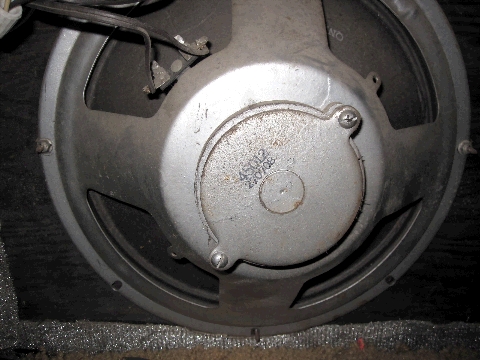 | Like every stock Gregory amp I have seen, the 12" speaker was made by Quam-Nichols. | 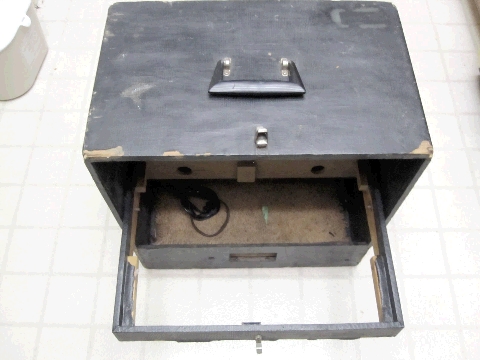 | Here is the slide-out rack that once held a record player. Thanks to Jim McSharry for contributing the information on this amp. |
The ADD-VERB
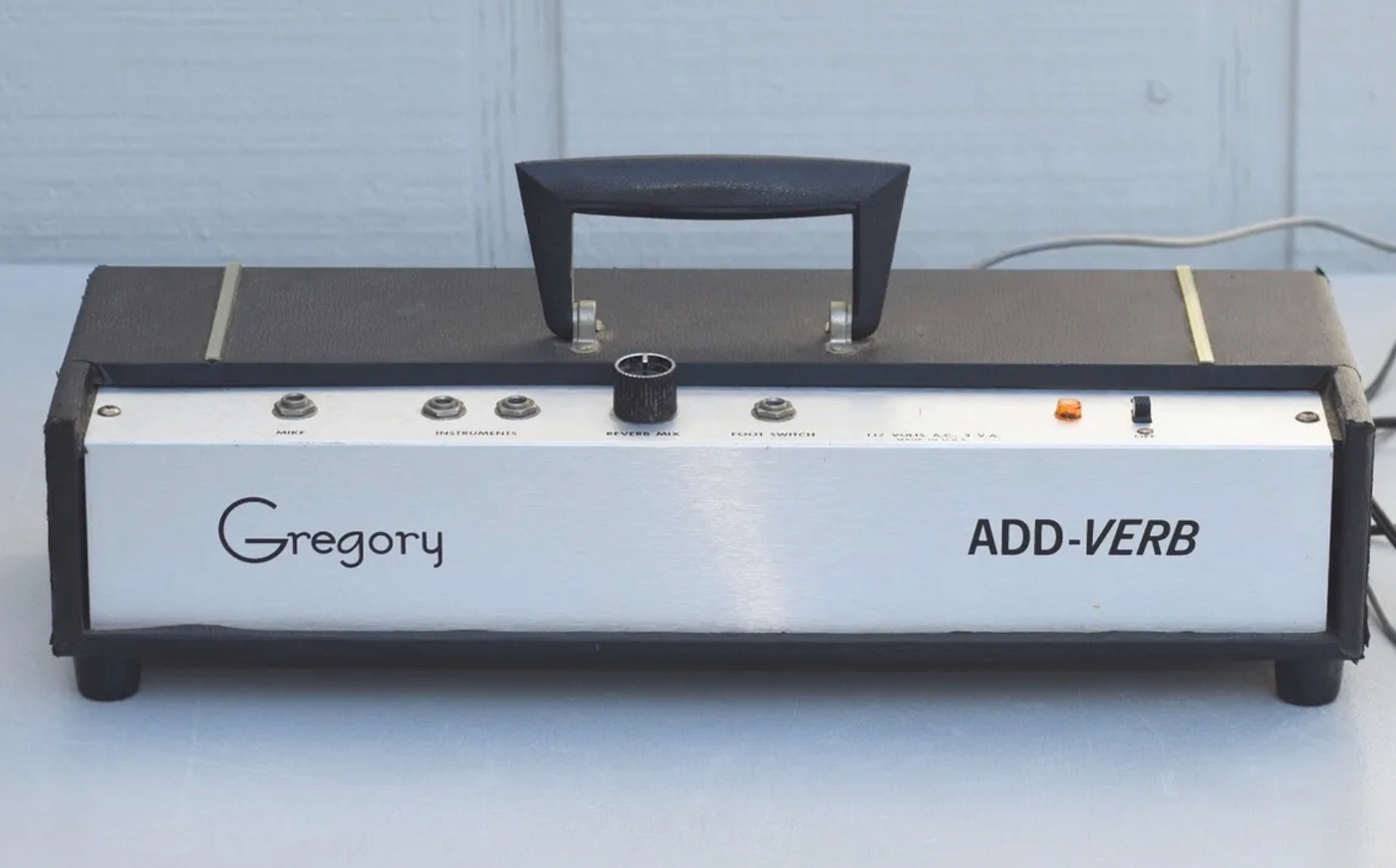 |
This is the "ADD-VERB", which is a solid state stand alone reverb unit. |
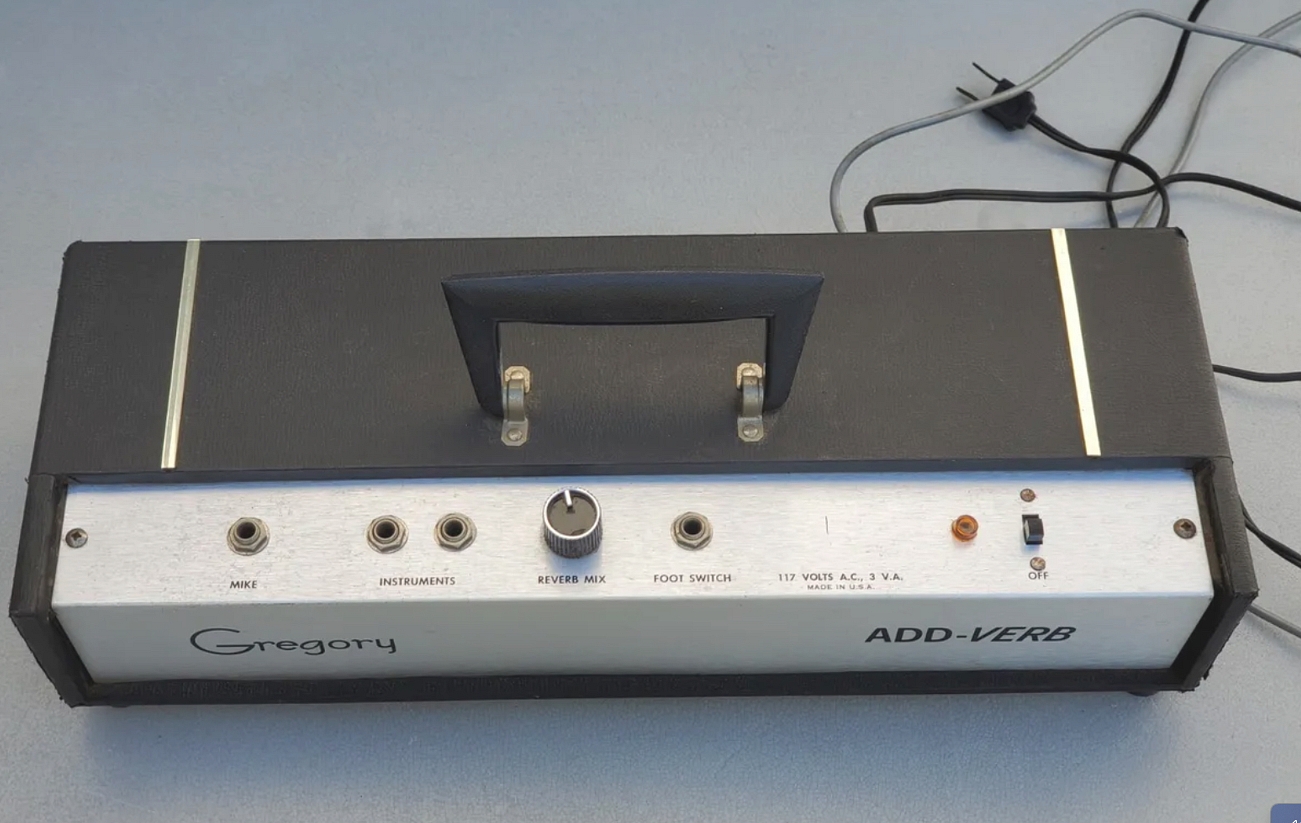 |
It has four 1/4" jacks - one labeled "MIKE", two labeled "INSTRUMENTS" and one labeled "FOOT SWITCH". Only one control knob, which is labeled "REVERB MIX". The on/off switch is a simple slide switch. |
 | It's a simple and relatively compact little unit. |
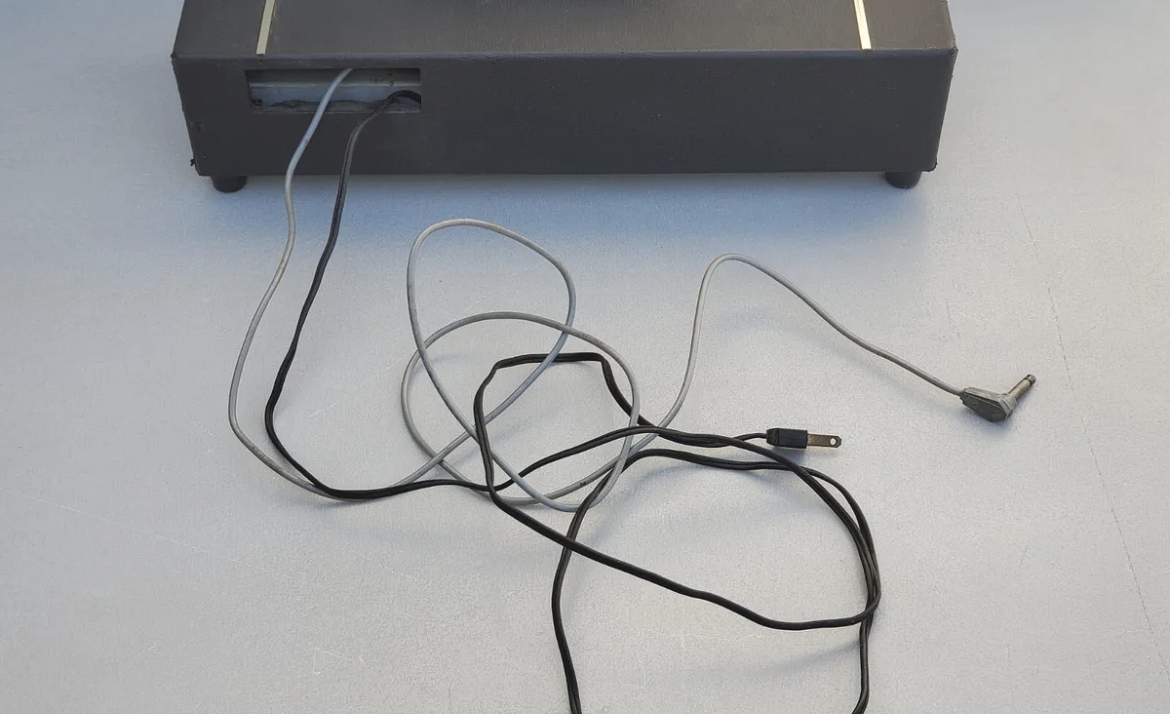 | Here is the back of the unit. The output is a permanently attached cable with a 1/4" male plug on the end of it. I don't have pictures of the inside but I have read they were built point to point using solder lug terminal strips. Reverb tank
has no markings on it. Click here for schematic. This unit appears to use a completely different circuit than the Gregory amps with built-in reverb. . |
Handi-Amp II
I need your help! If you have any info to contribute that is not found here, please contact me. I really need some pictures of the Mark Eleven. It appears that there might be a Mark XV in existence as well, but I have yet to confirm that. I am also needing schematics for many of these amps. I have a few of them, but I have a long way to go before I acquire all of them.